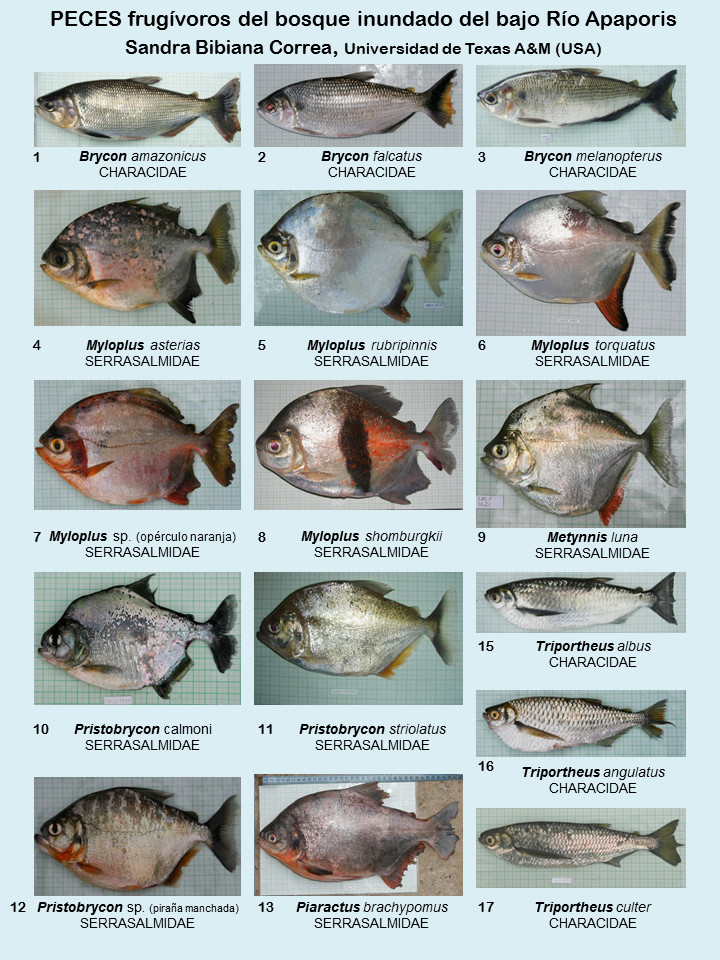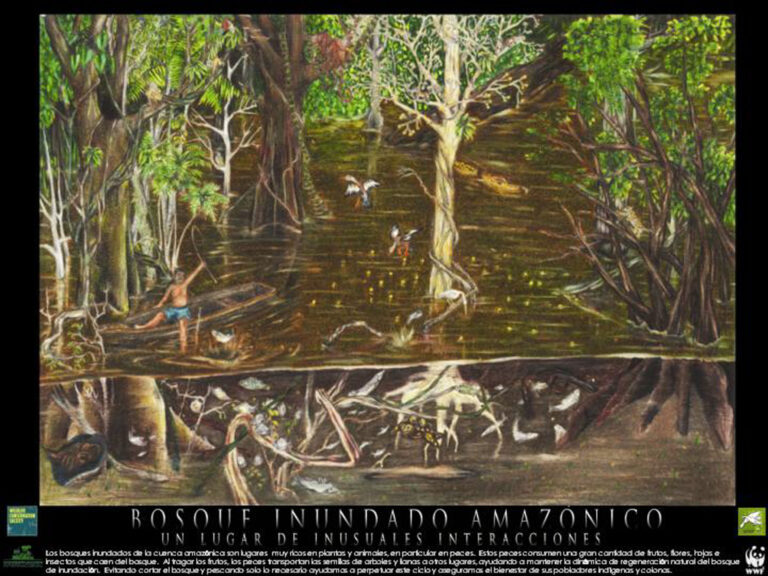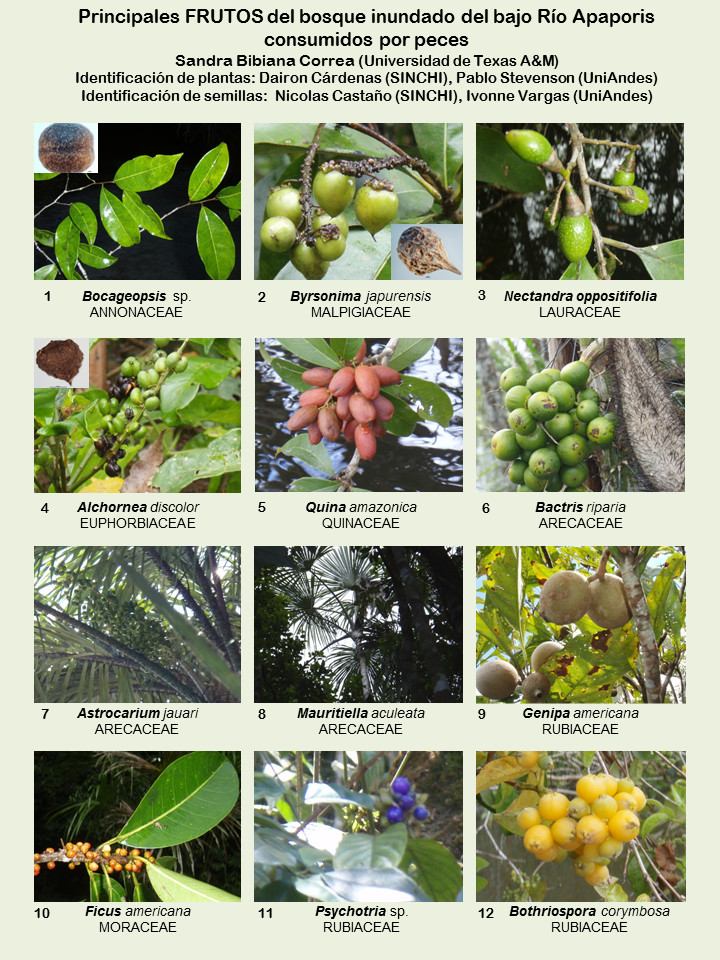expanding the science of river ecology
Banner photos: 1st photo, Apaporis River, Colombian Amazon, Credit to Sandra Bibiana Correa. 2sd photo, Vaupes River, Colombian Amazon, Credit to photographer Jorge E. Garcia-Melo (https://www.jorgegarciabiophoto.com/).
Frugivorous Fishes
What are frugivorous fishes? Nearly 300 fish species worldwide eat fruit at some point in their lives. That is because fruits fall from riparian and floodplain forest plants, and when fish eat the fruit, it gains energy and protein to support their metabolism and reproduction. At the same time, when eating fruit, these frugivorous fishes transport seeds and plant new trees. This is a key ecological interaction known as seed dispersal.
Fishes, like other wildlife, play essential roles in aquatic ecosystems. Our mission is to investigate and raise awareness about the ecological role of frugivorous fishes in planting forests and contributing to the maintenance of biodiversity in tropical wetlands. To learn more about this fascinating interaction, check out the results of our research projects in the Amazon and Pantanal wetlands of South America (see Publications).

Many frugivorous fishes are currently threatened by overfishing which endangers the persistence of floodplain forests and important inland fisheries. Since frugivorous fishes rely on fruits for a significant part of the year, they occupy low trophic positions in local food webs. This makes them energetically more efficient relative to predatory fishes. Thus, if managed correctly, frugivorous fishes could become a sustainable fishery that improves food security for low-income people in tropical regions.
Current Research
Evolution of Fish Frugivory and Seed Dispersal
Frugivory is a widespread feeding habit among tropical freshwater fishes, yet very few people know about this unique plant-animal interaction. In three synthesis articles (Correa et al. 2007, Bioscience; Horn & Correa et al. 2011, Acta Oecologica; and Correa et al. 2015a, Biological Reviews), we demonstrated that fish frugivory involves nearly 300 species of tropical and temperate fish and, just in the Neotropics, over 500 plant species. Among fishes, frugivory evolved independently in families of Neotropical and African Characiforms, and within Neotropical serrasalmids (i.e., Pacus and Piranhas), frugivory likely originated from an omnivore ancestor. Most importantly, fish evolved well before most other groups of vertebrate frugivores in South America, around 70 million years ago. This is a surprising finding that suggests that fish likely were the first seed dispensers in the New World and played important roles in structuring wetland plant communities and riparian forests.
Our work also demonstrated that fruit characteristics, such as having a fleshy pulp, facilitated the establishment of interactions between fish and fruits and the fish’s role as seed dispersers, known as ichthyochory.
Current research investigates whether fruit characteristics, including nutrient composition, influence the likelihood of seeds surviving fish consumption. Another line of research is investigating how characteristics of floodplain forests influence patterns of species distribution and richness of fruit-eating fishes in Amazonia.
Collaborators: Pablo Tedesco (University Paul Sabatier, France), Hernan Lopez-Fernandez and Matthew Kolmann (University of Michigan), Jill Anderson (University of Georgia), Jerry Pehna, Catia Nunes da Cunha, and Joisiane Araujo (Federal University of Mato Grosso, Brazil).
Past Projects
Linking Overfishing to Seed Dispersal Mutualism Disruption in Neotropical Wetlands
This is a collaborative research program that involves Colombian, Brazilian, and North American scientists to investigate the ecological role of fishes in wetland forest regeneration and to link overfishing with wetland biodiversity. Fieldwork was conducted between 2014-2017 in the Brazilian Pantanal and Colombian Amazon.
Our research demonstrated that fish disperse enormous numbers of diverse seeds, of both forest and savanna species. Interestedly, each frugivorous fish species seem to have different feeding preferences where they selectively consume particular fruit species irrespective of their availability in the floodplain. In the Pantanal, the most consumed fruits belong to the families Arecaceae, Convolvulaceae, Melastomataceae, Euphorbiaceae, and Rubiaceae. In comparison with smaller individuals, larger fish disperse more seeds of diverse plant species and are key dispersers of large-seeded species. As such, frugivorous fishes serve complementary services in local seed dispersal networks (see Publications).
Collaborators: Jill Anderson (University of Georgia), Jerry Pehna, Catia Nunes da Cunha, and Joisiane Araujo (Federal University of Mato Grosso, Brazil).
Resources


